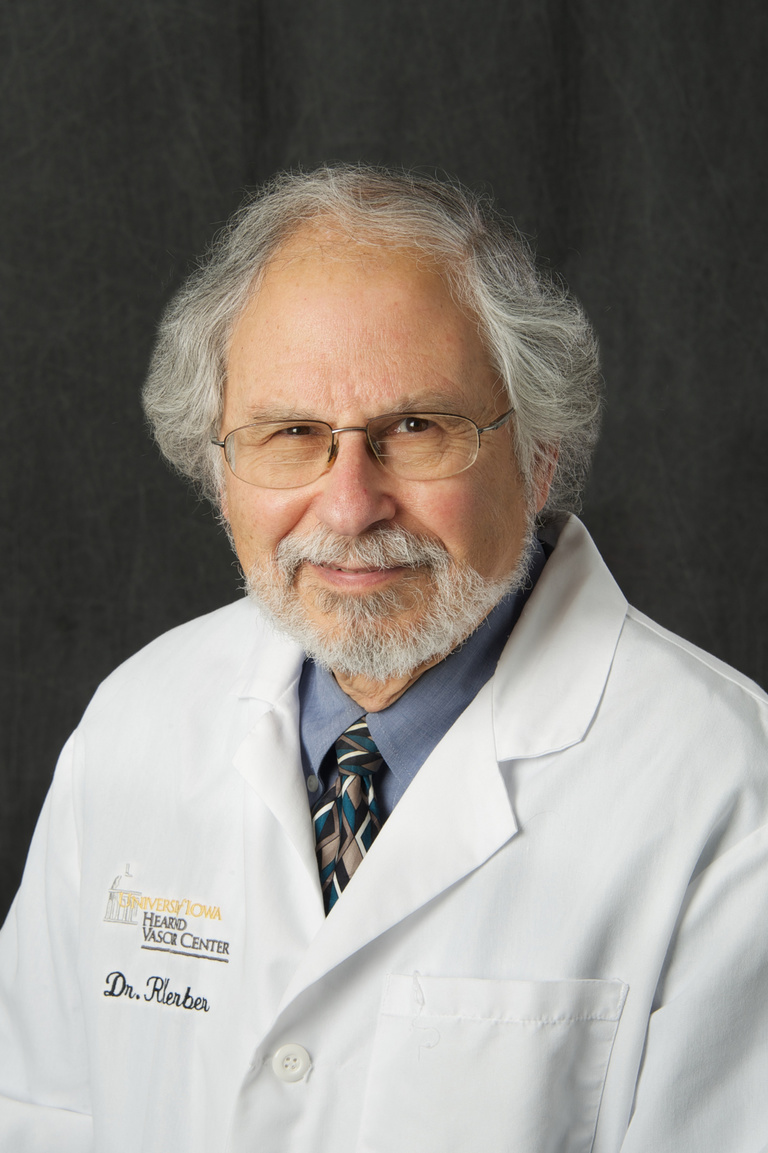
Nearly everyone knows that CPR (cardiopulmonary resuscitation)—rapid, rhythmic chest compressions—can save lives. Similarly, most people have seen AEDs (automated external defibrillators) deployed in public places such as airports and shopping malls. These devices can deliver an electric shock that restores a normal heart rate and rhythm in a person in cardiac arrest. But many people lack the basic training that would allow them to use these lifesaving techniques in an emergency.
The Richard E. Kerber HeartSafe Initiative aims to train University of Iowa faculty and staff working in non-medical buildings in CPR and the use of AEDs. The initiative also will increase the number and visibility of AEDs on campus, helping the UI meet the standards required to be certified as a HeartSafe Campus by the National Collegiate Emergency Medical Services Association.
Launched in 2017, the initiative honors Richard E. Kerber, who was a faculty member in UI Health Care’s Division of Cardiology for more than 45 years and was a pioneer in CPR research. He died in 2016 at age 77.
When Kerber joined the UI in the early 1970s, CPR was in its infancy. His work was instrumental in developing the accepted method for defibrillation in the American Heart Association’s CPR Guidelines, which have become the world standard for CPR. Kerber also was instrumental in the development of public access defibrillation programs whereby AEDs are placed in communities for use by bystanders.
Units desiring CPR and AED training can contact Fire Safety Coordinator Bruce McAvoy to schedule training. He can be reached at 319-335-5389 or bruce-mcavoy@uiowa.edu.
Sudden cardiac arrest is the third leading cause of death in the United States, affecting 350,000 Americans annually. People of all ages can experience sudden cardiac arrest. The overall survival in the U.S. is 10 percent, but the odds that an individual survives can be markedly improved if CPR starts within the first few minutes, followed, if indicated, by defibrillation. Mortality increases by 10 percent with each passing minute. Immediate CPR doubles or triples the chance of survival; defibrillation will double that figure.
Kerber, who is remembered as an exceptional physician-scientist and teacher, was dedicated to ensuring that research advanced clinical practice to benefit the whole community. He established, and for decades directed, programs that train faculty and staff at UI Hospitals and Clinics in CPR and regularly updated the training as best practices were modified by new knowledge.
However, no such systematic training has been available for faculty and staff in non-medical buildings on campus. Recognizing this gap, Kerber’s widow, Linda K. Kerber, UI professor emerita of history, created the HeartSafe Initiative to honor her husband’s memory and improve the safety of everyone who works on or visits campus. The Department of History was the first to embrace the challenge; 70 percent of its faculty, adjunct faculty, and staff are now trained. Also wishing to honor Kerber, the ZOLL Foundation, a Massachusetts nonprofit organization that supports research in resuscitation and acute critical care, has established the Richard E. Kerber Fund at the UI Center for Advancement.
“By achieving the goals in this initiative, Dr. Richard E. Kerber’s legacy of years of research into cardiac resuscitation will continue to live,” Linda Kerber says. “We hope to set an example for others. Most importantly, we will substantially increase the likelihood that persons suffering a cardiac event on our campus will survive.”
Since its inception, the initiative has resulted in 11 CPR training sessions for more than 85 people. CPR training also includes the use of the Heimlich maneuver to dislodge food that has been caught in the windpipe. Two dozen additional AEDs also have been installed in non-medical UI buildings. Forty-nine AEDs exist in non-medical, non-athletic campus buildings, part of the 117 AEDs across the entire campus.
“The American Heart Association and the Emergency Cardiovascular Care Committee have a goal of doubling cardiac arrest survival and to train 20 million people in CPR by 2020,” says Dianne L. Atkins, UI professor emerita of pediatrics and a longtime friend and colleague of Richard Kerber. “Organized programs in workplaces and communities are vital to achieving these goals. The Richard E. Kerber Memorial Initiative is part of this large goal, and we hope will improve the outcomes of cardiac arrest in our community.”
The initiative also has the support of UI President J. Bruce Harreld. Soon after his arrival in November 2015, staff in Harreld’s office completed CPR training.
“A fundamental purpose of a research university is to seek out ways to put discoveries into practice to improve the health and well-being of communities,” Harreld says. “This program is a great example of that and a fitting tribute to Dr. Kerber’s legacy.”
Hands-only CPR training event on June 7
From 11 a.m. to 2 p.m. on Thursday, June 7, staff from UI Health Care Emergency Medical Services Learning Resources Center (EMSLRC) will provide hands-only CPR training outdoors on the east side of the Pentacrest on the UI campus. In case of rain, the event will relocate to the second floor of the Old Capitol Town Center.
EMSLRC staff will use 20 mannequins to train people in hands-only CPR. The training is free.
For more information, email lori-hartley@uiowa.edu or call 319-353-7495.